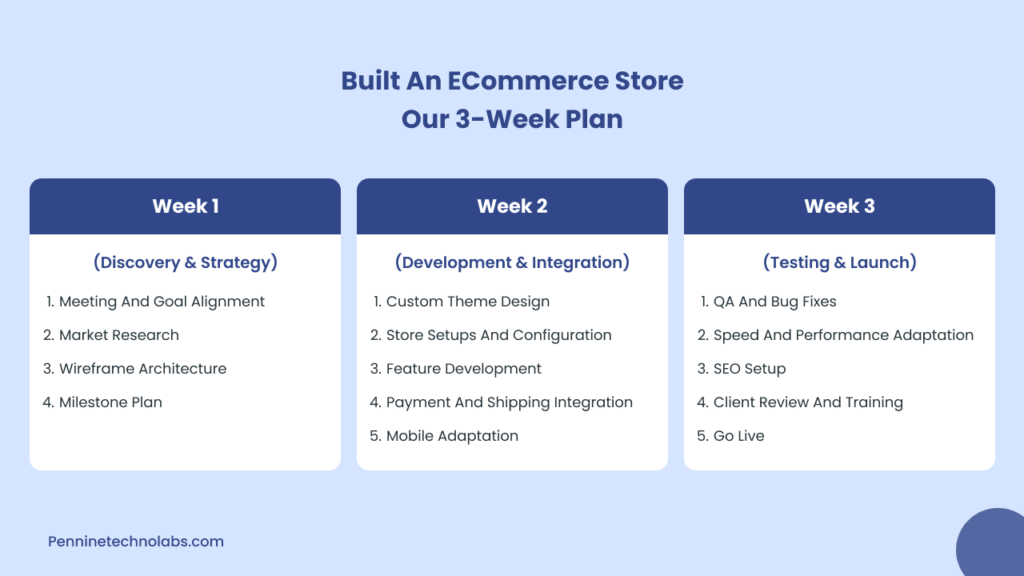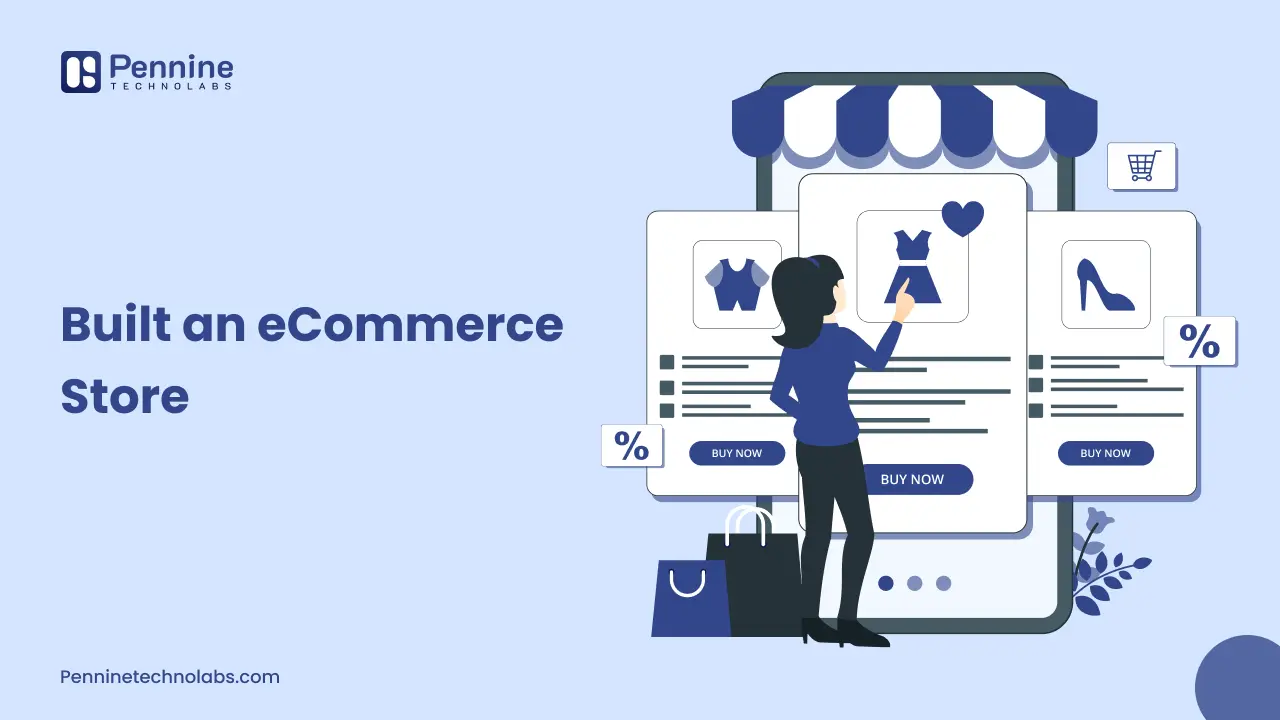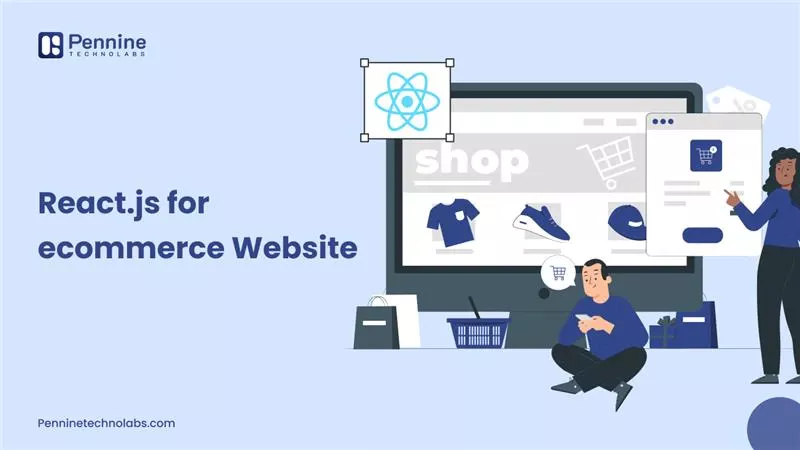Quick Summary: We built a fully functional ecommerce store in 3 weeks, which focused on the necessary features, using pre-made solutions, and by creating parallel to the functions. Week 1 Cover Planning and Setup, Week 2 focused on development, and Week 3 handled the test and launch-resulting in a fast, sales-ready store.
Launching a successful ecommerce store usually takes months of planning, designing, development, and QA testing. But when a customer comes to us with the immediate need to create and launch a completely functional online store in just three weeks, we knew that we had to move fast and do smart work.
Our team of eCommerce design and development, product managers, and web developers coordinated and planned the weeks with proper milestones and targets for the project. We achieved this ambitious goal through a step-by-step process, which we followed, and the way we faced challenges made the project successful.
The Background and Client Requirement
Our client was an emerging chocolate brand, preparing to launch its first online store, aimed at the crowd of seasonal shopping. He had already finalized the product lineup and branding, but there was no digital storefront.
- Their requirements were clear, which made our process easier and faster
- A modern and attractive store design with your unique brand identity
- Easy payment gateway, shipping, and tax configuration for their customer
- A mobile-first experience with rapid loading speed
- Basic SEO Implementation to ensure visibility
- Launch within 3 weeks to catch the upcoming chocolate season
This meant that we had to condense the months of planning and execution into 21 days without compromising on quality or user experience.
E-Commerce Store Development Process with Our 3-Week Plan
To make it possible, we divided the project into three clear stages:
- Week 1 – Search and Strategy
- Week 2 – Development and Integration
- Week 3 – QA Testing and Launch
This approach enabled us to systematically move forward, aligning both the client and our internal team.

Week 1: Discovery & Strategy
The first week focused on understanding the client’s targets and establishing a solid foundation.
- Meeting and Goal Alignment: We began with a detailed discussion with the client to understand their target audiences, product categories, and major preferences. This helped us decide on the most suitable platform. Shopify was chosen as it offered speed, scalability, and an easy-to-manage backend for the client’s small team.
- Market Research: We analyzed competitive websites to identify the design trends, conversion-driving features, and potential gaps, which we can fill to give our client a competitive edge.
- Wireframe Architecture: We quickly created wireframes for all major pages, including the homepage, category page, product extension page, and checkout flow. The move ensured that everyone had clarity on how the site would look and function.
- Milestone Plan: Within the 21 days, we divided the tasks into daily and weekly deliverables within the team, ensuring transparency for the clients to prevent stoppages.
By the end of week 1, we had a well-defined strategy, an approved wireframe, and a clear Shopify store roadmap.
Week 2: Development & Integration
With the Plan in place, week 2 was about execution. Our Shopify design and development teams worked simultaneously to speed up the process.
- Custom Theme Design: Using the approved wireframes, our Shopify designers created a clean, modern UI with a focus on conversions. We ensured that the design reflected the client’s brand personality and worked well across devices.
- Store Setups and Configuration: Our developers set up a Shopify store, configured the navigation menu, created a product collection, and uploaded product data with customized details and images.
- Feature Development: We applied conversion-focused features such as product filtering, quick ad-to-cart options, wishlist functionality, and automated email notification for abandoned carts. With the coordination of the customer, we optimized the design and features to meet all the requirements and to meet our development process.
- Payment and shipping integration: Stripe and PayPal were integrated as primary payment gateways. We also configured region-wise currency rates and exchange, including shipping rules, taxes, and inventory management.
- Mobile adaptation: Since most of the online shopkeepers browse on mobiles, we designed the store to be mobile responsive and ensure best performance on all screen sizes.
By the end of week 2, the store was functional and ready for internal testing.
Week 3: Testing & Launch
The final week focused on refining the quality and fine-tuning the online store.
- QA and Bug Fixes – We thoroughly tested the entire Shopify store, from product navigation to checkout flow, across multiple devices and browsers. Any issue was logged and resolved within hours.
- Speed and performance adaptation: To ensure a smooth user experience, we compressed the images, applied caching, and integrated a CDN to reduce the load time.
- SEO setup: We adapted basic structured data to optimize page titles, meta descriptions, URLs, and ensure Google search engine-friendly content with our in-house digital marketing team.
- Client Review and Training: We provided a staging link to the client for final review and guided their team on managing products, inventory, and orders for future use.
- Go Live: After approving the design, development, features, and content, we transitioned the store from staging to live. We then monitored and addressed any post-launch issues within 2-3 days.
Also Read: Confused between WooCommerce Vs Shopify? Check Now!
Ecommerce Challenges We Faced
In 3 weeks, delivering an entire ecommerce store was not without challenges.
- Lack of time – The biggest challenge was efficiently managing time. With any delay in the process, we had to plan according to the entire program. We reduced it by maintaining continuous communication and ensuring that approval was quick.
- Content and Product Data – Products and content management were time-consuming, and so it was a big task to get details of each product. We made templates and guidelines to make it easier for the customer’s team for future listings.
- Feature priority – With tight timelines, we focused on the main features for the launch roadmap and future promotional post-launch.
Despite these challenges, the cooperation between our team and the customer helped us stay on track and make the store live.
The Results
The store successfully went live in 21 days and started showing in Google Search engines.
- The client saw an increase of 40-50% in website traffic compared to its previous landing page-based setup.
- The store had a 2.5% conversion rate in the first week, which was higher than the industry average for new stores.
- Customer feedback highlighted the smooth navigation and easy checkout process of the store.
Key Takeaways
The project strengthened some major lessons about creating ecommerce stores on a short timeline:
- Clear communication is important – Fast approval and open communication kept the project on schedule.
- MVP first – Prioritize core features for launch and plan for recurring improvement.
- Breaking the project into process: Execution work with weekly stages helped us to stay organized and deliver within a time limit.
Ready to Launch Your Own eCommerce Store?
Launching an ecommerce online store does not mean cutting corners – this means the correct team, tools, and process are in place. Pennine Technolabs offers Shopify developers for hire who don’t compromise on design, performance, or scalability.
Whether you are a startup to launch your store online or a brand for expansion, we can help you create a conversion-focused ecommerce online store that builds your business. Our team specializes in Shopify development, WooCommerce development, and custom Ecommerce solutions to deliver and customize for launch on time.
From website maintenance, payment gateway integration, and product catalogue setup to SEO optimization and store post-launch support, we handle everything end-to-end.
Let’s talk about your project today. Together, Pennine ecommerce Development Company not only launches in weeks but also delivers long-term results, driving traffic, increasing sales, and building customer loyalty.
FAQs on Ecommerce Store
Which tools do you use for your eCommerce store development?
We use WordPress, WooCommerce, and Shopify, along with tools such as Klaviyo, ActiveCampaign, Omnisend, MailerLite, Stripe, PayPal, and Google Analytics, to ensure seamless performance and integration.
How much does it realistically cost to make a fully functional eCommerce store?
A basic store costs around $200-$500, while a custom, scalable solution can range from $700 to $ 1,200 or more. Hire Shopify developers from India for a more realistic pricing of a functional eCommerce Store.
How to make an eCommerce website for a small business?
While making a basic ecommerce website is easy. Choose an easy-to-manage platform like Shopify or WooCommerce, plan your products, set up payment gateways, and focus on speed, design, and SEO. We suggest hiring an expert ecommerce developer for a better setup and
What’s the most challenging part of building an eCommerce store?
The most challenging part is creating a seamless balance between user experience, performance, and scalability. Ensuring fast load times, secure transactions, and smooth integration across multiple systems, such as inventory, payments, and shipping, can be complex, especially as the store grows.
Can you integrate third-party tools like CRM or analytics into my eCommerce store?
Yes, our team can integrate tools such as HubSpot, Zoho CRM, Google Analytics, and inventory management systems to enhance automation and business insights.

